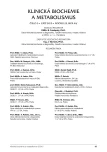The permissible limits for intermediate precision in control charts
Authors:
J. Ambrožová
Authors‘ workplace:
Oddělení klinické biochemie Nemocnice Prachatice, a. s.
Published in:
Klin. Biochem. Metab., 23 (44), 2015, No. 3, p. 109-115
Overview
Objective:
Presentation an advanced method for deriving correct permissible precision limits which are required for the correct use of control charts, and for the effective internal quality control management (IQC) in a laboratory practice.
Method:
The 3-signal table application designed by Haeckel and Wosniok [1], which provides appropriate means to calculate the correct permissible precision limits (pCVA) from the empirical biological variability (CVE), based on reference intervals (RIs); the subsequent proper use of pCVA in the control charts.
Discussion:
Potential uses of the 3-signal table [1].
Conclusion:
Warning against an improper use of the control charts; the correct method for deriving the permissible intermediate precision limits as the key ingredient for setting up effective control charts, which are a prerequisite for an objective classification of different laboratory methods according to their real quality.
Keywords:
permissible precision limits, quality classes, reference limits, control charts.
Sources
1. Haeckel, R., Wosniok, W. A new concept to derive permissible limits for analytical imprecision and bias considering diagnostic requirements and technical state - of-the-art. Clin. Chem. Lab. Med., 2011, 49(4), p. 623-635.
2. Cotlove, E., Harris, E. K., Williams, G. Z. Biological and analytic components of variation in long-term stu-dies of serum constituents in normal subjects. III Physio-logical and medical implications. Clin. Chem., 1970, 16, p. 1028–32.
3. Fraser, C. G. Biological variation: From Principles to Practice. Washington, DC: AACC Press, 2001, p. 1–151.
4. Klee, G. G. Tolerance limits for short-term analytical bias and analytical imprecision derived from clinical assay specificity. Clin. Chem., 1993, 39, p. 1514–8.
5. Acland, J. D., Lipton, S. Precision in a clinical laboratory. J Clin. Path., 1967, 20, p. 780–5.
6. International vocabulary of metrology – basic and general concepts and associated terms (VIM). ISO guide 99, 3rd ed. 2007, p. 1–104.
7. Jabor, A., Franeková, J. Principy interpretace laboratorních testů. Roche s.r.o., Diagnostic Division, Praha, 2013
8. Přehled přijatelných rozdílů v procentech pro kvantitativní zkoušky EHK, SEKK 2014 http://www.sekk.cz
9. Haeckel, R., Wosniok, W. A pragmatic proposal for permissible limits in external quality assessment schemes with a compromise betweeen biological variation and the state of the art. Clin. Chem. Lab. Med., 2012, 50 (5), p. 833-839.
10. Tonks, D. B. A study of accuracy and precision of clinical chemistry determinations in 170 Canadian laboratories. Clin. Chem., 1963, 9, p. 217–33.
11. CLSI. Defining, establishing, and verifying reference intervals in the clinical laboratory; approved guideline, 3rd ed. CLSI document C28-3c. Wayne, PA: Clinical and Laboratory Stan-dards Institute, 2010, 28, p. 1–50.
12. Arzideh, F., Wosniok, W., Haeckel, R. A plea for intra-laboratory reference limits. Part 2. A bimodal retrospective concept for determining reference limits from intra-laboratory databases demonstrated by catalytic activity concentrations of enzymes. Clin. Chem. Lab. Med., 2007, 45, p. 1043–57.
13. Arzideh, F., Brandhorst, G., Gurr, E., Hinsch, W., Hoff, T., Roggenbuck, L., et al. An improved indirect approach for determining reference limits from intra-laboratory databases exemplified by concentrations of electrolytes. J Lab. Med., 2009, 33, p. 52–66.
14. Richtlinie der Bundesärztekammer zur Qualitätssicherung quantitativer laboratoriums-medizinischer Untersuchungen. Dt Aerzteblatt 2003; 100: B2775–8. www.aerzteblatt.de/plus 1308.
15. Thomas, L. Clinical Laboratory Diagnostics, TH-Books GmbH, Frankfurt, Germany ISBN 3-9805215-4-0.
16. Web page Of the Nordic Reference Interval Project (NORIP) on the Internet: http://www.furst.no/norip. Accessed 9/30/2009.
17. Zdravotnické laboratoře – Požadavky na kvalitu a způsobilost ČSN EN ISO 1518 ed. 2.
18. Westgard, J. O. Basic QC Practices, 2nd. Ed., Westgard QC, Inc. 2002; ISBN 1-886958-17-3.
19. Tietz, N. W. Clinical Guide to Laboratory Tests, 2nd Ed., W. B. Saunders Company ISBN 0—7216-2486-3.
Labels
Clinical biochemistry Nuclear medicine Nutritive therapistArticle was published in
Clinical Biochemistry and Metabolism

2015 Issue 3
Most read in this issue
- Presepsin as a diagnostic and prognostic tool for sepsis
-
Bias měření základních analytů krevního séra.
Výsledky a interpretace soudobých studií. - Abstract of posters
- The permissible limits for intermediate precision in control charts
